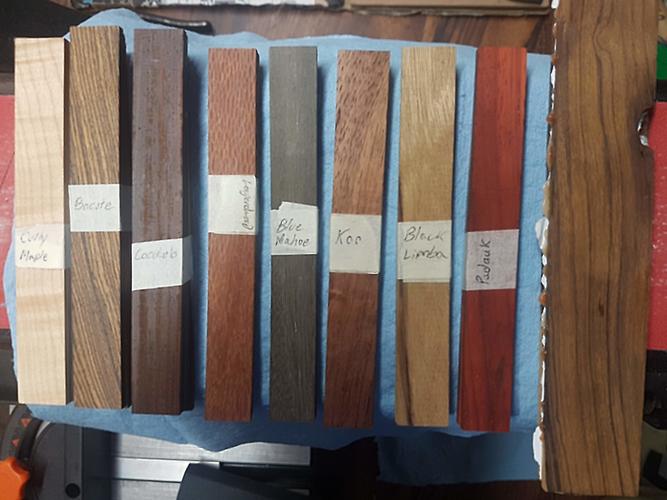Results 1 to 10 of 10
 38Likes
38Likes
Thread: New Woods!
-
11-30-2018, 02:11 AM #1Senior Member

- Join Date
- Dec 2016
- Posts
- 283
Thanked: 61 New Woods!
New Woods!
I've gotten a hold of a nice assortment of woods to play around with. Almost certainly I'll make scales with them of some kind but at this point essentially have no plan.

From left to right: curly maple, bocote, cocobolo, leopardwood, blue mahoe, koa, black limba, padauk -- all approximately 3/4" x 6" x 1/8", in pairs except the bocote and cocobolo, of which there are 4 pieces -- and the large one right on the end is desert ironwood.
-
11-30-2018, 02:18 AM #2

Nice line up. They'll make some awesome scales, for sure.
Mike
-
11-30-2018, 02:45 AM #3

Sweet! You've got some good ones there.
I was looking at that Koa remembering how much I like the texture you can get from woods like that.. most of the time guys will fill them with some kind of finish, but another option is to dig them out a little to give a nice texture.
Looking forward to seeing what you do with it all, until then it's always good to have a variety in your wood bank!“You must unlearn what you have learned.”
– Yoda
-
11-30-2018, 04:49 AM #4Senior Member




- Join Date
- Feb 2013
- Location
- Haida Gwaii, British Columbia, Canada
- Posts
- 14,455
Thanked: 4830
Nice. It is hard to find “local” wood with small enough grain patterns for scales. Even pacific yew is hard to find with small enough patterns.
It's not what you know, it's who you take fishing!
-
11-30-2018, 05:20 AM #5Senior Member

- Join Date
- Dec 2016
- Posts
- 283
Thanked: 61
I'm really curious about the koa. I was thinking I would try and avoid a CA finish with it precisely to help keep the nice texture to it. When you say 'digging it out' what exactly do you mean? Is there a finish you would recommend?
Yes, I agree! There is some nice birch at my parents' tree farm but I suspect it would probably need to be stabilized before using it for scales. What about juniper, or maybe dogwood?
-
11-30-2018, 11:15 AM #6

I've never used vacuum chambers and such to stabilize, looking forward to it. But when I had wood that needed stabilizing, I cut it relatively thin and used thin CA to soak in..
On digging it out, there are more than one way.
Get the wood to the shape you want it with sand paper, and then use steel wool. A buffing wheel will also do it a little depending on the wood... If it's soft enough.
The idea is to use a tool/sandpaper/device that will "get down" into those grooves.. Dig em out.
You can also use combinations. E.g.. Sand to shape with regular methods, then dig em out, then go back to a more rigid sandpaper to glide over the top surface..
So many cool little tricks with wood, you tube is a great place for that.
Edit: some woods I don't use finish. Depending on how oily it is, how dense, water resistant, etc.Last edited by MikeT; 11-30-2018 at 11:17 AM.
“You must unlearn what you have learned.”
– Yoda
-
The Following User Says Thank You to MikeT For This Useful Post:
ppetresen (12-01-2018)
-
11-30-2018, 02:02 PM #7

Lignum Vitae and walnut do not need a finish coat.
LV is awesome for scales.If you don't care where you are, you are not lost.
-
11-30-2018, 05:57 PM #8Senior Member




- Join Date
- Feb 2013
- Location
- Haida Gwaii, British Columbia, Canada
- Posts
- 14,455
Thanked: 4830
Well I have not had a chance to work with either juniper or dogwood. The idea intrigues me though. I think all the juniper around here is much to small, and we don’t have any dogwood.
It's not what you know, it's who you take fishing!
-
12-01-2018, 12:26 AM #9Senior Member

- Join Date
- Dec 2016
- Posts
- 283
Thanked: 61
-
12-01-2018, 12:52 AM #10

It was in original condition, faded red, well-worn, but nice.
This was and still is my favorite combination; beautiful, original, and worn.
-Neil Young
-
The Following User Says Thank You to Cangooner For This Useful Post:
MikeT (12-01-2018)



 LinkBack URL
LinkBack URL About LinkBacks
About LinkBacks






 Reply With Quote
Reply With Quote






